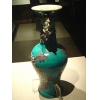|
 Today
the Japanese Chinaware is the most demanded and beloved china ware all over
Europe and in the rest of the world today for its sophisticated looks
and the elegant shapes. The trend in using the Japanese pieces of the
interior at home has also done its bit to increase the value and demand for the
chinaware. Today
the Japanese Chinaware is the most demanded and beloved china ware all over
Europe and in the rest of the world today for its sophisticated looks
and the elegant shapes. The trend in using the Japanese pieces of the
interior at home has also done its bit to increase the value and demand for the
chinaware.
The
Japanese Chinaware was invented much later than the Chinese countertype but
still has its own large history and has done a lot to the culture of the Rising
Sun Country firstly due to the popular tea ceremonies of Japan where the
chinaware played its part of not only being the container for the drinks but
also as a factor that increased the delight of the ceremony with its looks.
From
the beginning of time the Japanese Chinaware has always being valued above gold
and only the richest and most prosperous families could afford buying it. China
was such a precious gift that as a present it could easily settle down
international conflicts. The chinaware has always been kept carefully and was
showed rarely to the public and if so, it was the display of the great taste
and unbelievable magnificence.
The Sazuma, Kutani, Arita
chinaware is very well-known all
around the world for its sophisticated beauty. The chinaware of this class is
being stored at specially created places in Japanese houses such as alcoves or
wooden supports or low tables. Those supports are seen as a part of the flower
composition but still are being independent interior pieces which create a
specific tone in the whole area of the room.
Magnificent
vases, bowls and dishes from the Arita workshop became famous in Europe in 17th
century as the precious and expensive pieces of interior which were demanded by
all monarchs and kings. Those exotic bowls and vases painted all over the
surface with bright colors, golden and silver ornaments depicting flowers,
herbs, dragons, wonderful birds, animals, episodes from the samurai lives,
those bowls were bringing the spirit of the faraway and unknown land.
The
unbelievable fame came to the workshop in the 17th century after a talented
master called Kakiemon came up with the idea of the multicolor painting of the
goods. The forms of the goods were up to the merchants that would order a
specific amount of chinaware according to the catalogues of chinaware which
usually were Chinese. The requests usually included dishes, bowls, vases,
teapots, jars and pitchers all of which were usually sold in pairs for chimney
stands in the aristocratic houses of Europe.
Despite
the popularity in Europe Japanese chinaware was still very popular at the
domestic markets. It was served as decoration items in samurais' houses and that of prosperous
merchants. The precious chinaware indeed became a popular decoration in European houses as well as those in the east.
It
is rather interesting that master Kakiemon never marked his products and therefore all of the goods he had made were simply known as
Japanese chinaware in Western Europe, South-Eastern Asia and even in India. It
is only in the second half of the nineteenth century that the European
antiquarians and collectors have introduced the name of Kakiemon that from
there on meant the belonging of the chinaware to the Arita workshop.
There
was however another name for this specific type of chinaware. Due to the fact
that the Japanese chinaware came to Europe through the Imari harbor the
chinaware was long known in Europe as the Imari style china.
Today
at the world's auction houses the Japanese chinaware of 17th or 18th centuries
is as rare as it was hundred years ago. The prices for the items o the Japanese
chinaware at the auction houses vary from forty to ninety thousand us dollars.
Tom Cruise, Sharon Stone, Elton John and Whitney Houston are very well-known for
their passion and love for the Japanese chinaware.
Recent Japanese chinaware is also admired by many. And if speaking about bone china then the advantages of
the Japanese factory Noritake are simply unquestionable.
Glassy
in the light and richly decorated with the natural gold and platinum the
Noritake white chinaware is occupying one of the first places at the
international chinaware whiteness lists. The major part of Noritake production
is filled with the gift sets and with items made in Japanese styles.
The
table sets are usually produced at the small amounts by Noritake and therefore
the chinaware becomes a part of the antiques category as soon as it is produced
which increases the sets' price from year to year. The chinaware is unique with
its beauty since it's made from natural and ecologically positive ingredients
and materials. The chinaware is unique in its olive tincture and the ingredient
composition.
Chinaware
has always been valued from the ancient times until now and was considered as
the major indication of a family's prosperity and sufficiency. A sophisticated
chinaware set could very easily indicate the owner's taste and social status
without any words. Currently with the chinaware being even more popular and subject to a great range of sets to choose, one is only troubled by where to get something exclusive and unique. Yet, Japanese china ware is still the very item to find the way out, you won't loose.
|